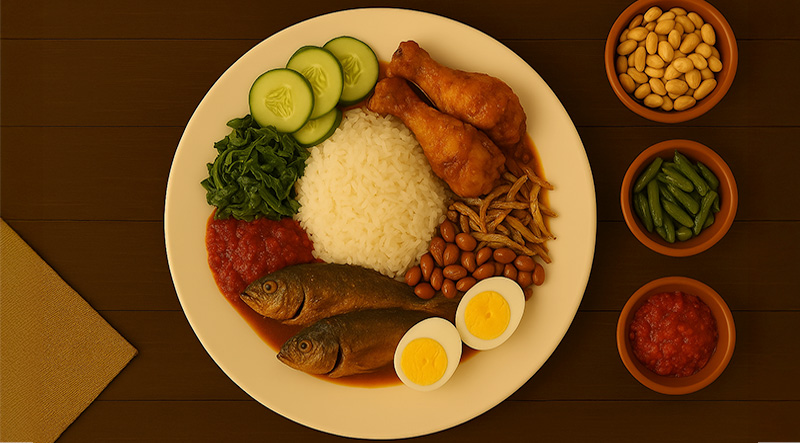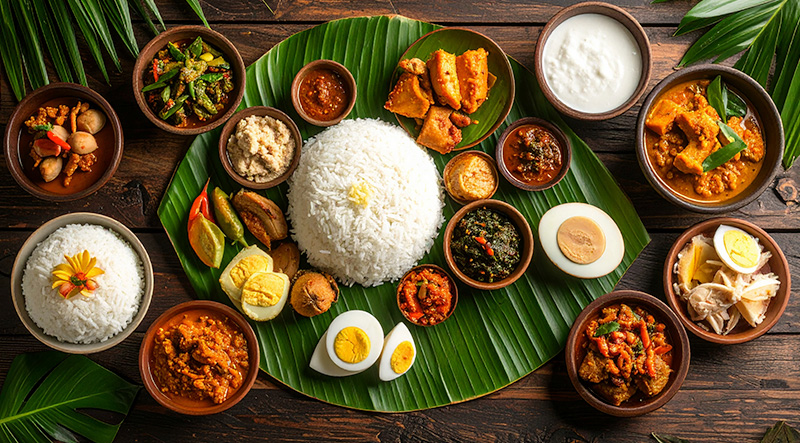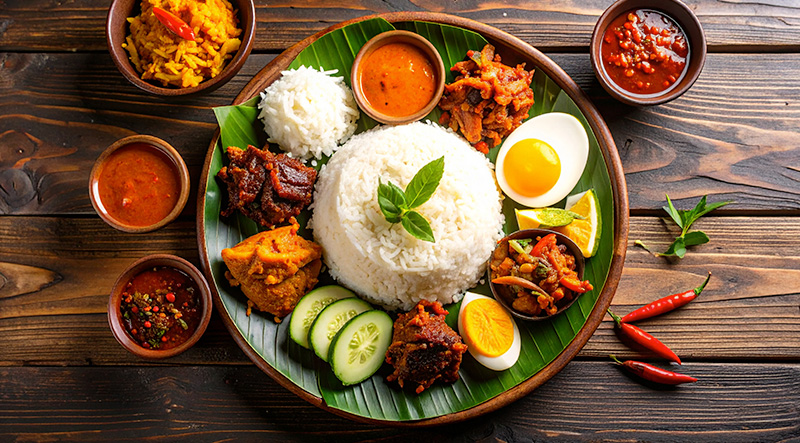Malaysia on a plate is Nasi Lemak, fragrant, spicy, and incredibly satisfying. This popular national dish combines a perfectly boiled egg, crispy anchovies, roasted peanuts, fluffy coconut rice, fiery sambal, and cool cucumber slices into a vibrant, flavorful feast. Nasi Lemak is a bold, delectable celebration of Malaysia's rich culinary heritage that goes beyond breakfast, whether it is served at a roadside stand wrapped in banana leaves or presented in a fine dining establishment. Read More...
The History of Malaysia’s National Dish – Nasi Lemak:
Nasi Lemak is more than a meal—it’s a national treasure. Often hailed as Malaysia’s unofficial national dish, this aromatic and satisfying plate of coconut rice, spicy sambal, anchovies, peanuts, cucumber, and egg has become an essential part of daily life for millions of Malaysians. But where did it all begin? The story of Nasi Lemak is one that reflects the heart of Malaysia’s history, agriculture, and multicultural identity.
From Village Fields to the National Table:
The origins of Nasi Lemak date back to traditional Malay farming communities, particularly in rural areas where rice cultivation and coconut farming were common. The term “nasi lemak” literally translates to “rich rice” or “creamy rice,” referring to the method of cooking rice in coconut milk, often with a few aromatic additions like pandan leaves, ginger, or lemongrass.
In early Malay villages, Nasi Lemak was a practical energy source for farmers heading out for long days in the fields. It was simple to prepare, filling, and highly nutritious. The inclusion of fried anchovies (ikan bilis) and boiled eggs added protein, while peanuts and cucumber offered texture and freshness. Wrapped in banana leaves for portability, it was a humble, hearty meal rooted in the land.
The Evolution of a Culinary Icon:
As Malaysia’s urban areas expanded and its population grew more diverse, Nasi Lemak evolved. In addition to its basic ingredients, regional and cultural variations began to emerge. Among the Chinese community, it became common to add fried chicken or curry, while the Indian Muslim (Mamak) stalls often served it with spicy rendang or sambal sotong (spicy squid). Each community infused the dish with its own flavors, enriching it while maintaining its core identity.
By the late 20th century, Nasi Lemak had transcended its role as a rural breakfast dish. It became a national favorite, served everywhere from street stalls to upscale restaurants. Its adaptability made it a symbol of Malaysia’s culinary diversity and unity—a dish that could be enjoyed by everyone, regardless of background.
Nasi Lemak in Modern Malaysia:
Today, Nasi Lemak is eaten at all times of the day—breakfast, lunch, dinner, or even supper. It is featured in school canteens, roadside warungs, five-star hotel buffets, and airport terminals. It’s often the first dish that Malaysians abroad seek when returning home, and a must-try for tourists discovering the country’s food scene.
The dish has also gained international recognition, appearing on menus in major cities like London, New York, and Sydney as Malaysian cuisine grows in popularity. Despite its global reach, the essence of Nasi Lemak remains unchanged: comforting, flavorful, and deeply Malaysian.
Cultural Significance:
Nasi Lemak represents more than just taste—it reflects Malaysian identity and unity. Its core ingredients highlight the country’s agriculture: rice from paddy fields, coconuts from coastal regions, anchovies from the sea, and spices from the tropics. Every bite tells a story of Malaysia’s natural bounty, colonial history, and multicultural fabric.
It’s also a symbol of togetherness. Nasi Lemak is often enjoyed communally, whether at a family table or a roadside stall, fostering a sense of shared experience and belonging.
Conclusion: A Dish That Defines a Nation:
From its humble village origins to its status as a global culinary ambassador, Nasi Lemak has remained true to its roots while adapting to modern tastes. It is a dish that connects past and present, tradition and innovation, and people of all walks of life. In every sense, Nasi Lemak is Malaysia served on a plate—rich in flavor, culture, and identity.
Prepare the Coconut Rice:

Make the Sambal:

Prepare the Accompaniments:

Assemble the Nasi Lemak:

Tips & Notes:
Nasi Lemak is the perfect example of balance in a meal—spicy sambal, creamy rice, crunchy textures, and refreshing cucumber all come together for a bite of Malaysia’s culinary heritage.
The total preparation and cooking time for Nasi Lemak is approximately 1 hour to 1 hour and 15 minutes. This includes about 15–20 minutes of preparation for rinsing rice, blending sambal ingredients, and prepping sides, followed by 40–55 minutes of cooking time—covering the coconut rice (15–20 minutes), sambal (20–25 minutes), boiling eggs, frying anchovies, and assembling the dish. If you add optional proteins like fried chicken or rendang, allow an additional 30–60 minutes depending on the recipe.
A single serving of Nasi Lemak, based on the provided recipe, contains approximately 600–700 calories. This estimate includes about 300 calories from the coconut rice (due to the combination of rice and coconut milk), 100–150 calories from the sambal (depending on oil and sugar content), and roughly 200–250 calories from the accompaniments like fried anchovies, peanuts, egg, and cucumber. If optional proteins like fried chicken or rendang are added, the calorie count can increase by an additional 200–400 calories, bringing the total to 800–1,100 calories for a deluxe version.







